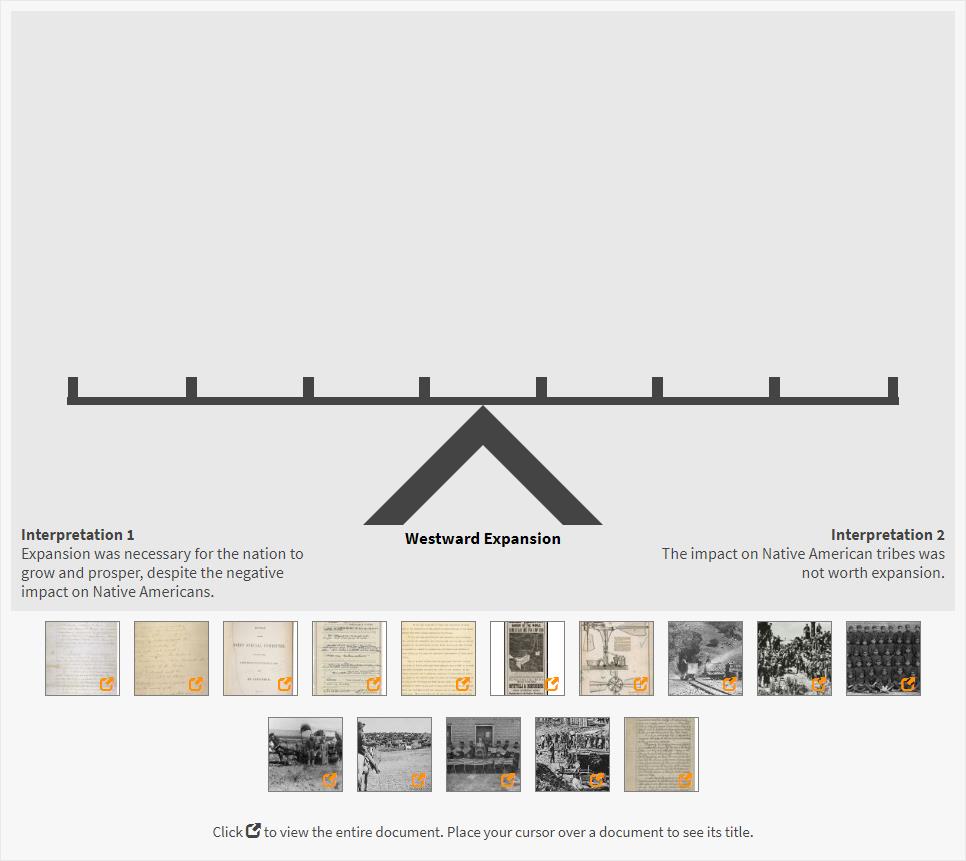In this activity, students will use primary sources as historical evidence to determine if western expansion was worth it.
Suggested Teaching Instructions
This activity can be used during a unit on westward expansion, or to explore how primary sources can provide varying perspectives on a topic. For grades 9-12. (To adapt the activity to middle school, have one group of students analyze one or two documents to present to the class and then move the documents to the scale as a full class.) Approximate time needed is 40 minutes. This activity can be done in class in small groups, or individually outside of class.
The goal is to demonstrate to students that the topic of westward expansion includes a great diversity of people, all in the west for their own reasons, with different perspectives and aspirations. Native Americans living in the west at the time were not one monolithic group, but of different tribal nations with distinct cultures. Students can't rely on stereotypes or make assumptions based on the term "Native American." Likewise, workers and new settlers in the west were not all the same—Chinese and Irish immigrants, African Americans, and native-born Americans from the east had varied experiences and motivations. The issues on which conflicts centered are not simplistically two-sided, with one faction good and the other bad, one right and one wrong. Each group and individual in every conflict was driven by unique priorities and visions. In this activity, students should grasp and grapple with such complexities.
To begin, choose one document to display to the full class and
model document analysis.
Then ask students to open the activity and to carefully analyze each document below the scale. They should evaluate each document and then move it to a position on the scale according to whether it supports the conclusion
Expansion was necessary for the nation to grow and prosper, despite the negative impact on Native Americans or The impact on Native American tribes was not worth expansion, and how strongly. Remind students to not only consider whether the documents support the conclusions, but to notice other factors as well:
- How relevant are the documents to the topic?
- Are they from a credible source?
- Whose perspective are they from?
- Who were the intended audiences?
After they have finished moving the documents, hold a class discussion about why they placed specific documents where. Ask students:
- Why did you place each document where you did?
- Why do some documents carry greater weight?
Ask students to consider their personal backgrounds, as well as historical and societal impacts, and to think about the impact these might have on their interpretation. Additionally, ask them what perspectives are missing or what other kinds of documents should have been included to tell the full story. Remind them that documents can differ by creator, purpose, level of detail, and in a myriad of other ways.
Follow up with a class discussion about the strengths and weaknesses of using primary sources as historical evidence and the importance of pulling in sources from a variety of collections and repositories. Discuss the breadth of historical evidence and the challenges of coming to more complex and general conclusions—and that history doesn’t neatly fit into this or that conclusion, but is messy.
Specific discussion points could include:
- The documents in this activity all come from the holdings of the National Archives, meaning they were either created for, or saved by, the Federal Government (or both). Will they include every perspective?
- Every family was represented on the Hopi petition. This might add credibility. But consider too that the intended audience was the U.S. Government, and the petition could present only information that proved the distribution of land under the government’s policy would be detrimental.
- In considering the golden spike photo, students might discuss photography’s capacity to document reality—a critical achievement, but also point out the prevalence of staged photos in our society, even back then. They could also question the relevance of the photo: Does a photograph excluding ethnic minorities who worked on the railroad show the whole truth?





